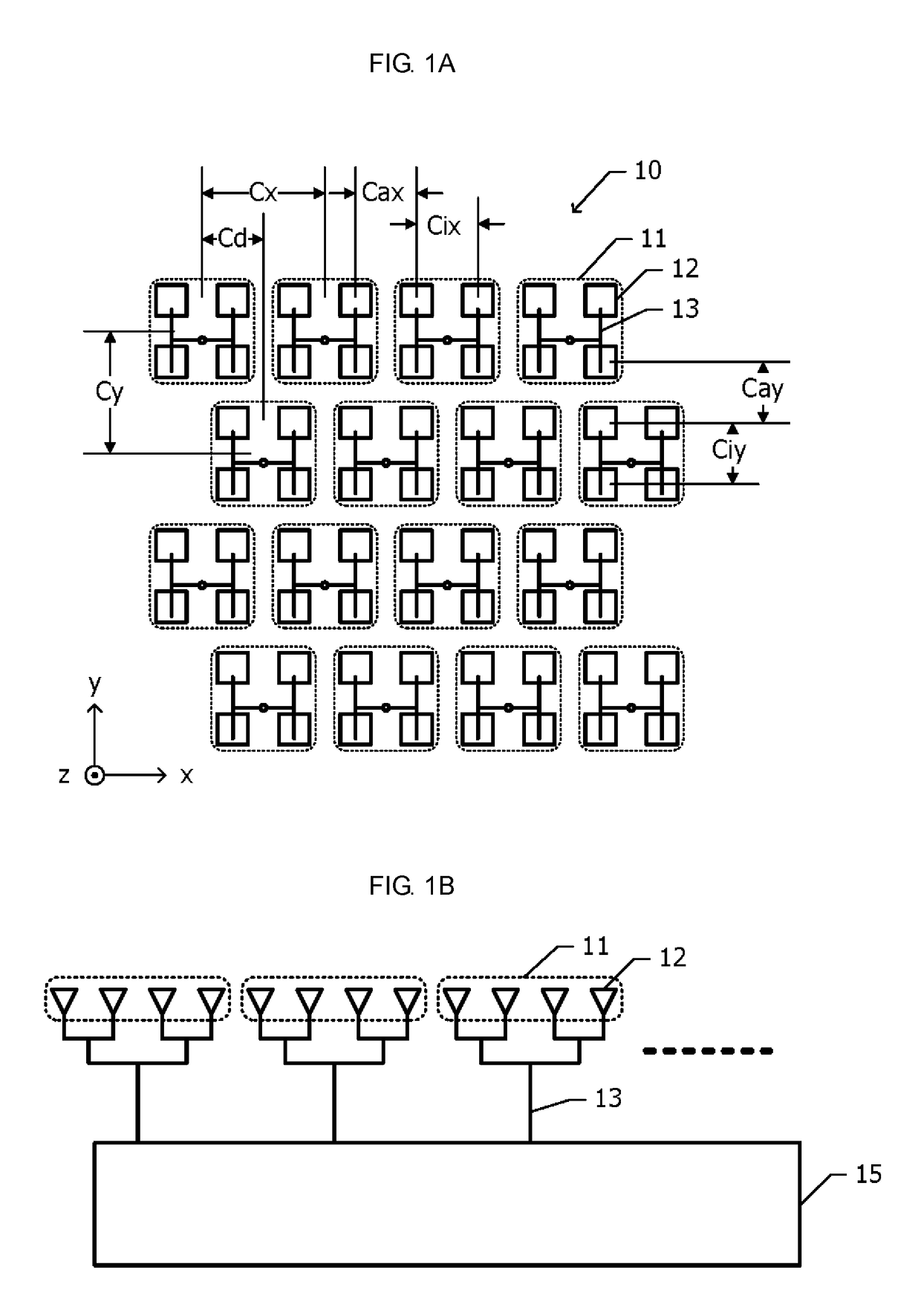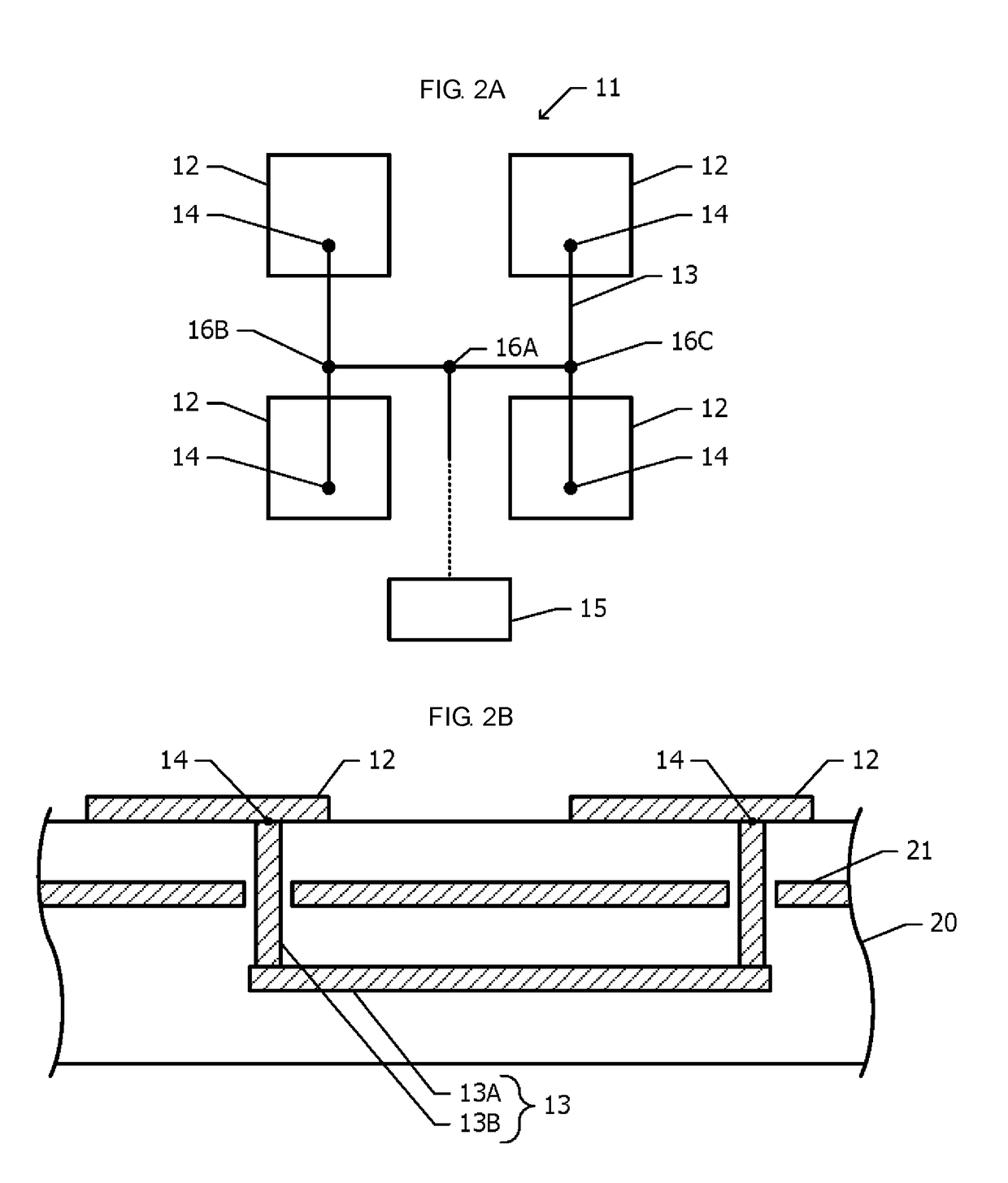Array antenna
a technology of array antenna and antenna array, which is applied in the direction of antennas, electrical devices, individually energised antenna arrays, etc., can solve the problems of increasing the number of targets to be subjected to phase shift control, the array antenna cannot be made to operate as an active phased array antenna, and the beam steering cannot be performed in this direction, so as to achieve high antenna gain
- Summary
- Abstract
- Description
- Claims
- Application Information
AI Technical Summary
Benefits of technology
Problems solved by technology
Method used
Image
Examples
first embodiment
[0027]An array antenna according to a first embodiment will be described while referring to FIGS. 1A to 2B.
[0028]FIG. 1A is a plan view of an array antenna according to a first embodiment. An array antenna 10 according to the first embodiment includes a plurality of sub-arrays 11 that are two-dimensionally arranged in an x direction and a y direction, which are perpendicular to each other. For example, a total of sixteen, i.e., four in the x direction and four in the y direction, sub-arrays 11 are arranged. Each of the plurality of sub-arrays 11 includes four radiating elements 12 that are arranged in a two-row by two-column matrix in which the x direction is a row direction and the y direction is a column direction. Patch antennas are used as the radiating elements 12.
[0029]The arrangement of the radiating elements 12 inside the sub-arrays 11 is the same in the plurality of sub-arrays 11. A high-frequency signal is supplied to each radiating element 12 via power feeding lines 13 th...
second embodiment
[0044]Next, an array antenna 10 according to a second embodiment will be described while referring to FIG. 3. Hereafter, the description of the parts of the configuration that are identical to those of the array antenna 10 according to the first embodiment illustrated in FIGS. 1A to 2B is omitted.
[0045]FIG. 3 is a plan view illustrating one sub-array 11 and a part of a power feeding line 13 of the array antenna 10 according to the second embodiment. In the first embodiment, the power feeding points 14 are arranged at positions that are shifted in the same direction from the centers of the radiating elements 12 in all of the radiating elements 12 (FIG. 2A) inside one sub-array 11. In the second embodiment, in any two radiating elements 12 that are adjacent to each other in the y direction, the power feeding points 14 are arranged at positions that are shifted by the same distance in directions such that the power feeding points 14 move closer to each other from the centers of the rad...
third embodiment
[0048]Next, an array antenna 10 according to a third embodiment will be described while referring to FIGS. 4A to 4C. Hereafter, the description of the parts of the configuration that are identical to those of the array antenna 10 according to the first embodiment illustrated in FIGS. 1A to 2B is omitted.
[0049]FIG. 4A is a plan view of one sub-array 11 of the array antenna 10 according to the third embodiment. In the first embodiment, one sub-array 11 includes four radiating elements 12 (FIG. 1A), whereas in the third embodiment, one sub-array 11 includes eight radiating elements 12. The eight radiating elements 12 are arranged in a four-row by two-column matrix. The power feeding line 13, which is connected to the high-frequency input / output device 15, extends to each of the plurality of radiating elements 12 via three branching points.
[0050]As illustrated in FIG. 4A, the directivity with respect to the y direction can be made sharper by arranging a greater number of radiating eleme...
PUM
 Login to View More
Login to View More Abstract
Description
Claims
Application Information
 Login to View More
Login to View More - R&D
- Intellectual Property
- Life Sciences
- Materials
- Tech Scout
- Unparalleled Data Quality
- Higher Quality Content
- 60% Fewer Hallucinations
Browse by: Latest US Patents, China's latest patents, Technical Efficacy Thesaurus, Application Domain, Technology Topic, Popular Technical Reports.
© 2025 PatSnap. All rights reserved.Legal|Privacy policy|Modern Slavery Act Transparency Statement|Sitemap|About US| Contact US: help@patsnap.com



